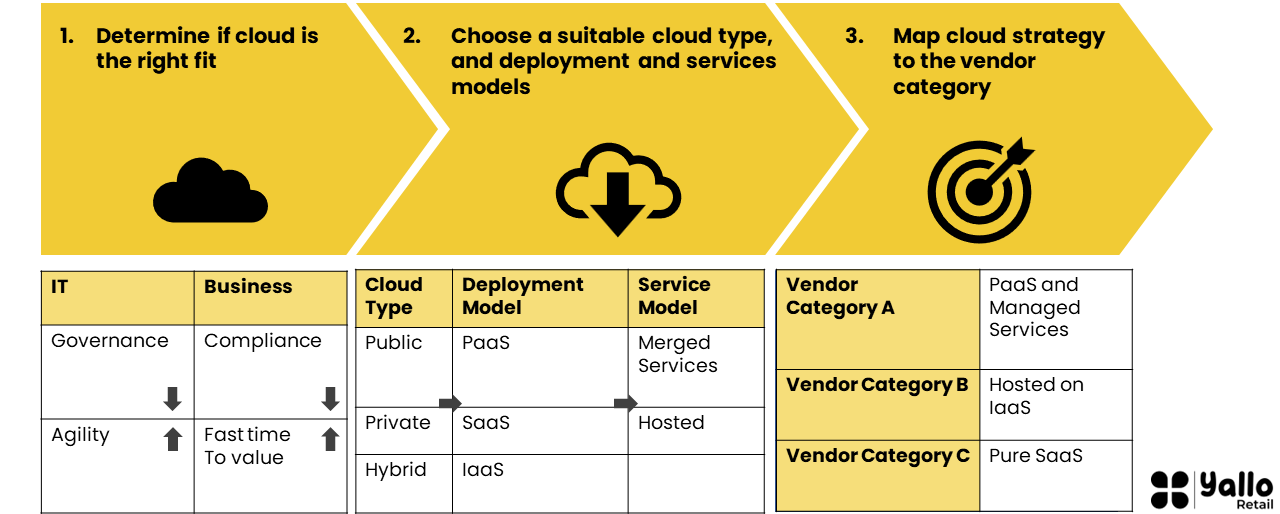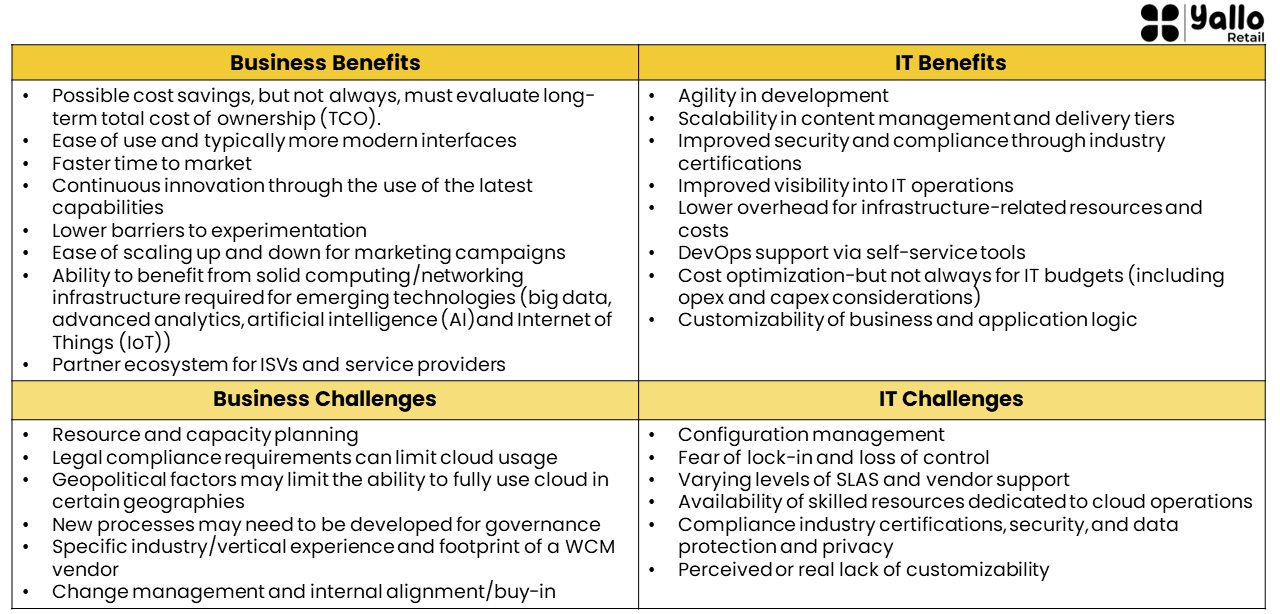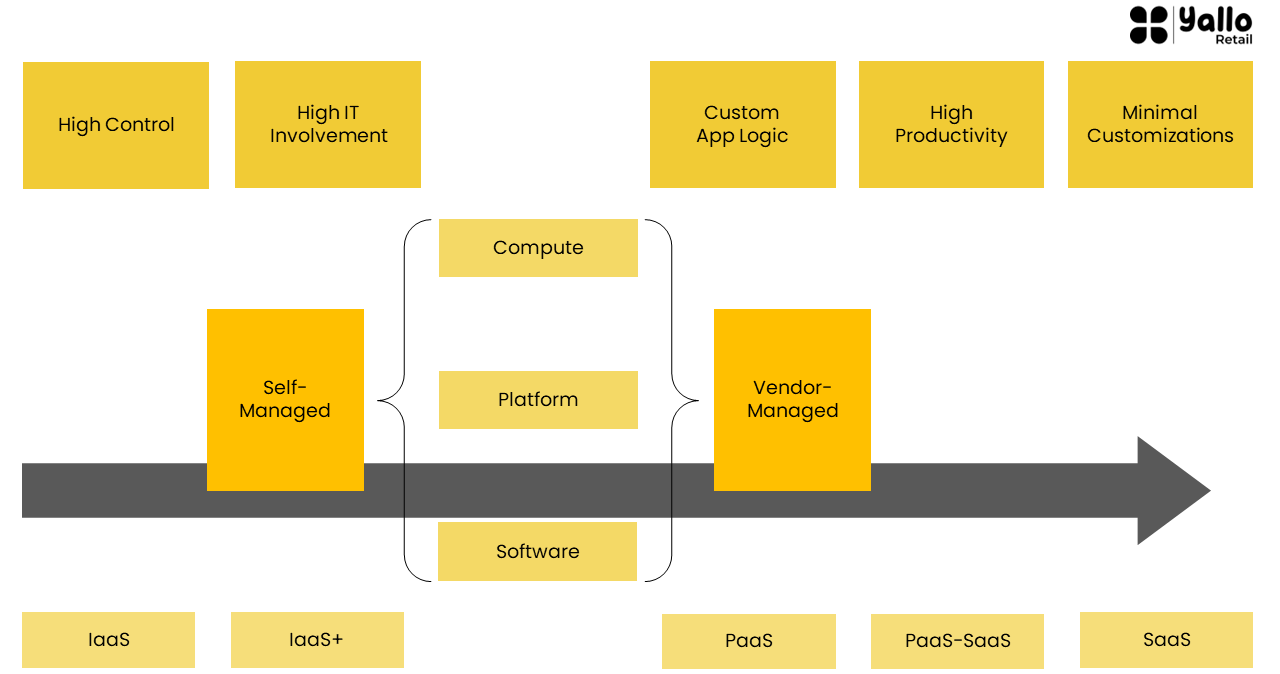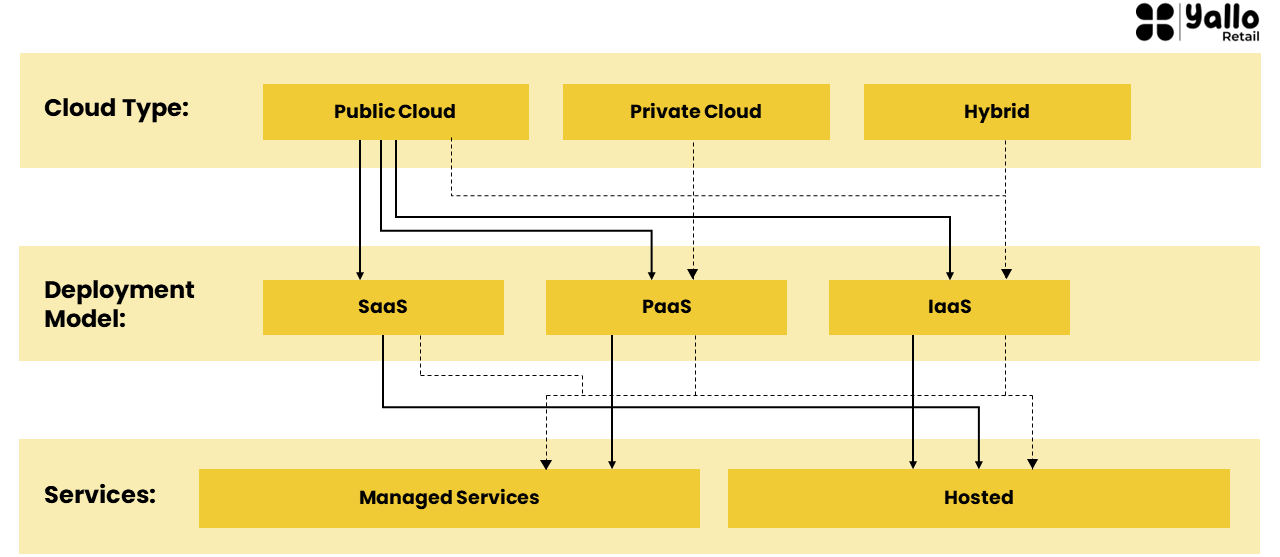Web content management customers mostly struggle to take advantage of cloud benefits due to market confusion. IT leaders responsible for WCM programs must decide whether cloud is right for them, and then identify the suitable models and align them to the vendor categories.
Few considerations
Staying with on-premises web content management (WCM) systems limits the ability to innovate, be agile and benefit from faster time to value.
Confusion over multiple cloud and deployment models (public, private, SaaS, PaaS, etc.) leads to inertia and reluctance to move to the cloud.
IT leaders feel overwhelmed when attempting to shortlist suitable cloud WCM vendors, risking misalignment with digital strategy.
Analysis to be done
Application leaders responsible for WCM initiatives must:
Determine if cloud WCM is the right choice by mapping the benefits and challenges against the organization's strategic goals.
Identify which type of cloud and deployment model will best meet the needs of your organization by using the framework provided.
Choose the appropriate WCM vendor type by matching your desired cloud approach to the vendor categories.
Moving WCM to the cloud
Customer experience (CX) is the new competitive battlefield. It is driving digital urgency, immediacy and faster pace of innovation. With WCM technologies at the heart of the digital experience and CX initiatives, application leaders responsible for WCM are under pressure to provide an agile and scalable infrastructure and empower their business partners to innovate faster. A cloud-first approach can give organizations a faster pace of innovation, greater scalability and agility.
Application leaders' task is to determine if and when cloud WCM is appropriate for them. Yet, they struggle to articulate the related benefits and challenges that cover both the IT and the business.
A second complication here is the multitude of choices when it comes to cloud types (public or private cloud), deployment models (IaaS+, SaaS or PaaS) or services models (hosted or managed services). It can be challenging to determine the right mix of models. Clients are asking: How is PaaS different from SaaS? Is public cloud the right choice for us?
Here are the three recommended steps for moving WCM initiatives to the cloud to best support digital business strategy and customer experience programs.
The Three-Step Framework for Moving WCM to the Cloud

Figure 1. The Three-Step Framework for Moving WCM to the Cloud
Study
#1: Determine if Cloud WCM Is the Right Choice for You
Despite "cloud" being a well-known term by now, many organizations are still unsure whether they should be moving their WCM operations to the cloud, or how to best execute on that move.
Type A organizations (see Note 1) are often aggressively adopting cloud applications in an all-cloud strategy. The drivers include rapid innovation and faster time to market, and the imperatives of digital urgency.
On the other side of the spectrum, Type C organizations are reluctant to move WCM to the cloud after having made a significant investment in on-premises implementations and internal talent development. They may also have concerns about security, data privacy regulatory compliance and disaster recovery, which prevents them from fully embracing the cloud.
By examining the sample benefits and challenges in Figure 2, you will start developing your own pros and cons, and mapping them against your organizational goals and cloud strategy. This exercise should be carried out in collaboration with business/marketing counterparts that need to actively participate and voice their input.
Benefits and Challenges in Adopting Cloud WCM for IT and Business

Figure 2. Benefits and Challenges in Adopting Cloud WCM for IT and Business
In addition, you could develop a ranking system specific to your organization in order to assign weights to the benefits most important to you (see the example in Table 1)
Table 1: Rating the Benefits of Cloud WCM
| IaaS | PaaS | SaaS |
Business Benefits |
|
|
|
Cost control | Medium | High | High |
Ease of use | Low | Medium | High |
Faster time to market | Low | High | High |
IT Benefits |
|
|
|
Agility in development | High | High | Low |
Customizability | High | High | Low |
Scalability | High | High | Medium |
When there's a low benefit, along with high or unmanageable challenges, the approach should be avoidance, but with a plan of revisiting analysis and decision making on a periodic basis.
Once you have examined these potential benefits and challenges in moving your WCM operations to the cloud, the next step (if applicable) is to navigate the cloud type and deployment models.
#2: Identify the Best-Fit Cloud Type and Deployment Model
In identifying the best-fit WCM system in the cloud, you need to make two key decisions and select the most appropriate:
1. Cloud type
2. Deployment model
Choose the Most Suitable Cloud Type for WCM
Most commonly, WCM solutions are deployed and managed in the following types of clouds:
Public cloud: The majority of WCM implementations run on instances of public clouds such as Amazon Web Services (AWS), Google Cloud or Microsoft Azure. These are typically multitenant offerings.
Private cloud: This choice is usually driven by high demands and highly specific business challenges. It most often applies to organizations running WCM programs for certain highly regulated verticals, such as government or financial services. Private cloud can be internal or single-tenant external.
Hybrid model: In practical terms, for the WCM industry, hybrid means the ability to run WCM services across on-premises as well as cloud environments. Hybrid WCM approach can be necessary if business needs or legal, compliance regulations require that some data, process or functionality must be managed or controlled on-premises. You could also consider the hybrid approach as an interim solution in your cloud migration strategy, but you should be aware of potential added complexity.
Another hybrid scenario is when distinct WCM instances of the same implementation may be split between public and private cloud environments. However, this across-cloud WCM approach is usually required only in extremely challenging scenarios.
Choose the Most Suitable Deployment Model for WCM in the Cloud
Some of the most commonly used deployment models for WCM in the cloud are as follows:
Infrastructure as a service (IaaS): Mostly a rare choice when it comes to the WCM technology landscape. IaaS provides "bare metal," which is the basic building block for the infrastructure, storage, cloud computing and networking, but not for WCM applications out of the box. Clients need to install, maintain, patch, and support their WCM applications themselves. Many WCM systems can be managed and hosted on IaaS, but WCM vendors don't normally provide managed services. IaaS deployment also puts the responsibility of running upgrades for your WCM system on your shoulders — much like in the on-premises setup. Clients manage the end-to-end process, not only of the WCM software, but also the underlying cloud infrastructure.
Platform as a service (PaaS): One of the most common models in the WCM industry. PaaS allows organizations to focus specifically on using and getting the business benefits from the WCM application, and any associated development, extensions and customizations, without having to worry about the underlying cloud infrastructure. WCM vendors take responsibility for the health, versioning and patching of the application infrastructure software in addition to the underlying system infrastructure software stack.
Software as a service (SaaS): While SaaS WCM is one of the most mature categories in the WCM technological landscape, it has relatively low adoption, especially in large enterprises. Usually in a multitenant/shared services environment, vendors provide WCM software as a service that clients subscribe to. Customers can utilize prebuilt content management functionality, but less so develop any customizations for it. The vendors manage upgrade rollouts to the entire customer base. This option is less appropriate for independent development or significant extension of the SaaS offering, limiting customers to mostly configuration of the standard WCM application.
Cloud Continuum for WCM

Figure 3. Cloud Continuum for WCM
Hosted Versus Managed Services for Cloud WCM
The two key decisions discussed above provide you with the infrastructure and deployment capabilities for content management software and delivery. But there's another layer of decision making, and this is where organizations often fall victim to the confusion between two typical services models: hosted and managed services.
The choice between hosted or managed services will largely depend on the type of the deployment model you choose. Be aware of the terminology used by WCM vendors, as it can be used interchangeably. It is critical to get to the actual meaning in that specific context.
Table 2 and Figure 4 provide guidance on comparing the most common services models in cloud-based WCM:
Table 2: Hosted Versus Managed Services for Cloud WCM
Hosted | Managed Services |
Typically applies to IaaS and IaaS+ | Typically applies to PaaS |
The provider (not always the same as your WCM provider) provides the infrastructure to host your WCM application | The provider provides a range of additional services (e.g., monitoring, autoscaling up/down, tools, dedicated resources, CI/CD, DevOps, self-service tools, etc.) |
Usually comes at a lower cost (but with a more intense need for resources) | Depending on the type of SLA (99.5% or 99.9%, dedicated customer success engineer or lack thereof, 24-hour or 48-hour response times, etc.), price can range significantly |
Not many variables to consider, aside from an established provider and footprint | Many variables to consider, such as environment sizing. SLAS, support availability, self-service tooling availability, vendor maturity and product strategy |
Consider for non-mission-critical, SMB or departmental implementations | Can be a good fit for midsize and enterprise implementations, but requires examination of SLAs for uptime and overall cost |
Example: Hosting supplier A provides hosting of WCM Solution X on its cloud infrastructure | Example: Vendor B provides managed services for its WCM solution in the Microsoft Azure Cloud PaaS model |
Potential Paths to Deciding on the Right Mix of Models for WCM in the Cloud

Figure 4. Potential Paths to Deciding on the Right Mix of Models for WCM in the Cloud
#3: Match the Desired Cloud Approach to the Vendor Categories
The third key step is to match the desired cloud strategy, as identified above, to the vendor categories and their corresponding capabilities.
As discussed in "How to Shortlist WCM Vendors for Your Digital Business Strategy," we apply an eight-step framework to this process. Specifically for Step 6, Match This Architecture to the Vendor Categories, we advise on how to categorize vendors. This helps you to differentiate among best-of- breed point solutions, enterprise solutions and "marketing clouds" categories.
You should extend this step from the above-mentioned eight-step framework to include cloud vendor categories and capabilities that are required to support your cloud strategy. Rather than identifying individual suppliers, your organization should begin by choosing the vendor type that is most suitable to your goals.
Vendor Category A: Private cloud, PaaS and no managed services
A sample scenario:
We need robust security, proven expertise in our vertical and verifiable compliance with industry standards. We have internal expertise and staff to provide that. Therefore, we'll investigate PaaS WCM solutions that can "live" entirely in our private cloud. No managed services will be required.
Vendor Category B: Public cloud, hosted on IaaS+
A sample scenario:
We need to implement a departmental solution for an open-source WCM system for a small microsite. We have a solution in mind, but don't want to manage and maintain it ourselves. We need to find a hosting provider to do that work for us. IaaS+ works for us because we don't need to scale, and the hosting provider still takes care of the underlying infrastructure.
Vendor Category C: Public cloud, multi-tenant SaaS
A sample scenario:
We are only interested in a SaaS WCM, as it best aligns to our business goals and our current digital maturity level. We have simple digital marketing websites and need to launch microsites quickly. The managed services model is not available in this case. However, we are confident that the support provided by SaaS subscription services will be sufficient for our needs.
In addition to evaluating vendor categories and their alignment to your business goals and use cases, it is important to investigate the top priorities that will influence your decision. Application leaders exploring cloud WCM options should, for instance, investigate:
Vendor SLAs, available vendor expertise and how they impact your business operations.
Security certifications (or lack thereof), compliance and data privacy.
Openness and interoperability in terms of the depth and breadth of APIs available.
Costs, which can vary widely for SaaS versus PaaS WCM implementations.
Availability of best practices, guidance from vendor and tools supporting proactive monitoring, self-service tools, CI/CD and DevOps.
Vendor product strategy and vision, cloud offering maturity and ability to execute.
Finally, remember that WCM is at the front and center of your overall digital business strategy. It's a mission-critical piece of your technology stack. WCM technologies should be treated as part of the overall enterprise cloud strategy, and never as a silo.
